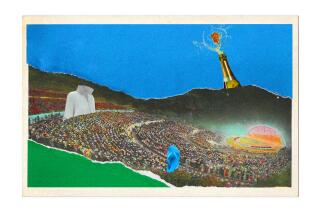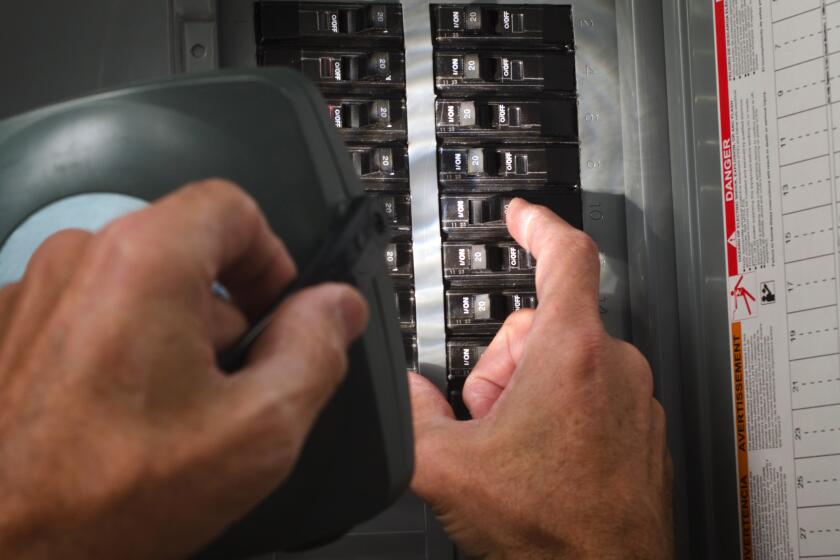Column: They raised tens of thousands of dollars to fix a dangerous intersection. Now they can’t get the city to take action

Alexander von Wechmar and Rob Ramsey, who live down the street from each other, have seen a lot of befuddled drivers negotiate their long-troubled intersection in the Hollywood Hills.
Canyon Drive and Bronson Avenue come together in an awkward union. It’s as if Bronson isn’t sure where it wants to go, so it forks into Canyon at two points, forming a large triangle in the middle and confusing many a driver.
“It’s not clear who has the right of way,” says Von Wechmar.
Stop signs have been mowed down repeatedly, says Ramsey. Von Wechmar says one motorist plowed through a temporary barricade in the middle of the triangle in 2005, blasted into Von Wechmar’s retaining wall and died.
It’s a wonder Batman and Robin managed to speed up to the Bronson Canyon caves all those years without killing someone.
Residents take on a dangerous intersection
After the motorist died, Von Wechmar and Ramsey stood at the intersection together one day and watched a driver spin around the circle like he was on a merry-go-round.
“Rob said, ‘This guy’s showing us what we need here,’ ” recalls Von Wechmar, who had just returned from Germany and saw firsthand the benefits of a well-planned traffic circle.
And so began, in the year of the Lord 2005, a 12-years-and-running battle with L.A. City Hall in an attempt to safeguard pedestrians and motorists alike with the installation of a simple circular median.
In those early days, Von Wechmar approached Tom LaBonge, the district’s city councilman at the time. Von Wechmar said LaBonge was receptive and consulted an engineer, then asked the city Department of Transportation to look into it.
“The city provided a technical drawing, a bird’s eye view,” says Von Wechmar, and a neighbor, artist Carolin Q. Wild, produced a lovely rendering of a landscaped traffic circle with a vintage street lamp in the middle of it.
But things grind along slowly at City Hall, and before long, residents were told the city did not have the money to install a traffic circle.
No joy in Bronson Canyon
“It was designed to be one of those blow-off statements,” says attorney Mike Gatto, who had not yet become a state assemblyman and was consulting the residents at the time. “We don’t trim the trees because we don’t have the money. We don’t pave the streets because we don’t have the money…. But what was different about this group was that they said, ‘Okay, the city doesn’t have the money. Then we’re going to raise it ourselves.’ ”
Gatto helped them set up a nonprofit, the Oaks & Bronson Canyon Improvement Fund, which collected its first donations in late 2008.
“They literally went door to door,” said Gatto, and took in $10 here, $50 there, sometimes $100 and occasionally more.
The recession had hit by then, and the fundraising dragged but did not stop. In 2013, after five years of work, the group reached its goal of nearly $70,000.
But there would be no joy in Bronson Canyon.
Von Wechmar says the five-year approval period for the project had expired, triggering new discussions with bureaucrats. Then came a disagreement about whether to go with yield signs or stop signs, followed by doings with the streets department, engineering, the Department of Water and Power, and so on and so forth. The residents hired an engineer, at a cost of $2,500, to support their cause. Then came the back and forth about the street lamp.
“Data had to be obtained from the manufacturer to calculate light distribution and output levels generated by the LED fixtures,” Von Wechmar wrote in a summary of the ordeal.
“You’d think we were asking for a zoning variance to build a nuclear reactor,” says Ramsey (full disclosure, Ramsey and I are friends).
Gatto says it’s been like the drill where Charlie Brown keeps running up to kick the ball, and Lucy pulls it back at the last second.
$25,000 permit fee? ‘This can’t be true’
When residents were finally hoping to proceed, the city informed them they’d have to pay permit fees to move things along.
To the tune of $25,000.
“We said, ‘You’ve got to be kidding. This can’t be true,’ ” says Von Wechmar, who’d had his fill of reminders that no good deed goes unpunished.
I’m with Von Wechmar. The Oaks is not a low-income neighborhood, and the city — which still can’t manage its budget or guarantee basic services — has lots of far more urgent matters to deal with than traffic circles. No question about it.
But when residents dip into their own pockets for street improvements, permit fees ought to be waived. Someone please send a memo to Mayor Eric Garcetti, Council President Herb Wesson and the rest of the gang. Are we going to be hauling our own trash soon and paying a permit fee at the dump?
Residents went back to LaBonge, who got the permit fee chopped to $18,500 and promised to cover the amount from his district’s discretionary fund. But that took months for the city to process, and then LaBonge was termed out and replaced in 2015 by David Ryu, who set up a task force to review all discretionary-fund projects before money was released.
Can this intersection be saved?
That took several months. Next up, says Von Wechmar, the city told him only half the discretionary funds could be used to cover permit fees. He objected and never heard whether the matter was resolved.
“Then I hear we need to get more testing done, welding joints have to be tested, this and that. I’m trying to talk to a guy who I know has the authority to say yes to all of this, and he doesn’t return phone calls or respond to my emails,” said Von Wechmar. “All the time I have invested in this is unbelievable. It’s hours and hours and hours per week, and it’s insane.”
But it got crazier still.
In mid-August, the city sent out a notice that it was repaving the street where the intersection sits. The notice advised that any street excavation will be prohibited for one year after the repaving, meaning the traffic circle project would be delayed, assuming it ever begins.
What’s all the more galling to Von Wechmar and Ramsey is that their street doesn’t really need repaving. But the city often gives priority to moderately worn streets because the horrible ones are too expensive to fix.
I spoke to Ryu, who said he’s on the case and intends to speed things up. The repaving has been delayed at his request, because as he said, it makes sense to install the traffic circle and repave the street at the same time.
When I visited the intersection, Ramsey pointed out where a jogger had tripped over a crack on his sidewalk and sued the city.
“But the city dodged the issue, so he came after me,” said Ramsey, whose insurance company paid the jogger $190,000 and threatened to cancel Ramsey’s policy if he didn’t fix his sidewalk. Ramsey said he hired a friend to fix it, without a permit, and if city officials have a problem with that, he’s ready to pump them a one-finger salute.
Across the street from his house is one of the most spectacularly uplifted sidewalks I’ve seen in a city with thousands of them.
“You need a sturdy rope and crampons” to get by it, said Ramsey, a screenwriter, and he wasn’t exaggerating.
Ramsey, Von Wechmar and I watched as one car after another blew through a stop sign and whizzed past the spot where there might be a traffic circle one day, in a not-too-distant decade, but who’d put money on that?
Get more of Steve Lopez’s work and follow him on Twitter @LATstevelopez
MORE FROM STEVE LOPEZ
Bye-bye Silver Lake, hello Pacoima: How one couple tackled L.A.’s sky-high real estate prices
A Westside apartment with all the amenities for less than $500 — but you had to win the lottery
After her life in L.A. unraveled, a woman living in her car hopes to regain health and employment
More to Read
Sign up for Essential California
The most important California stories and recommendations in your inbox every morning.
You may occasionally receive promotional content from the Los Angeles Times.







